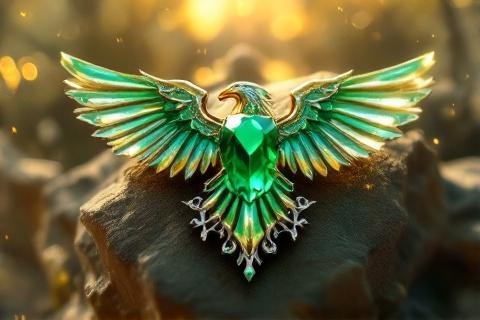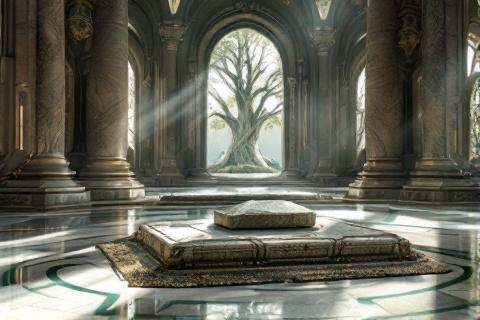
Elessar: The Elfstone of Healing
A Jewel of Hope for Kings and Healers
The Origins of the Elessar

The Elessar stone's origins can be traced to the hidden city of
Gondolin during the First Age, where it was
crafted by the renowned Elf-smith Enerdhil, whose skill was said
to rival that of Fëanor himself. This remarkable jewel
emerged from Enerdhil's deep understanding of both craftsmanship and healing
arts, created during the height of Gondolin's splendor.
The stone's most remarkable quality lay in its unique power to restore the
appearance of age and decay, revealing things as they existed in their prime.
When one gazed through the green crystal, withered flowers would appear in full
bloom, and aged trees would seem young and vibrant once more, though this was
achieved through enchantment rather than actual restoration.
When Gondolin fell to Morgoth's forces in the First Age,
the Elessar was among the few precious artifacts that survived the city's
destruction. Through the chaos and tragedy of that terrible night, the stone was
preserved and carried to safety along with other refugees who fled through
Idril's secret passage, ensuring that this powerful artifact of healing would
endure beyond the city's fate.
Physical Description and Properties
The physical form of the Elessar was a testament to Elvish craftsmanship at its
finest, featuring a clear green stone of remarkable clarity set within an
intricate silver mounting shaped as an eagle with outstretched wings. The eagle
design held deep significance, representing the hope and aid that often came
from the Great Eagles in times of need.
The stone emanated a tangible healing energy that those sensitive to such powers
could perceive even without looking through it. Its restorative influence
extended beyond mere appearances, carrying genuine healing properties that could
aid in recovery and renewal.
When used as intended, those who peered through the Elessar witnessed a
remarkable transformation of the world around them. Age seemed to fall away from
all they beheld, revealing the vibrant essence that lay beneath the wear of
time. Gardens appeared as they had in spring, ancient forests regained their
youthful vigor, and the scars of time momentarily vanished from the landscape.
The Stone's Journey Through Time

Following the fall of Gondolin, the Elessar's journey led it into the
safekeeping of Lady Galadriel during the Second
Age. This transfer ensured the stone's powers would continue
to serve the forces of good in Middle-earth, as Galadriel
possessed both the wisdom to use it properly and the strength to protect it.
According to some accounts preserved in Elven lore, Celebrimbor, the greatest
Elven-smith of the Second Age, crafted a second Elessar. This new stone was
reportedly made for Galadriel herself, though whether this was to replace the
original or to complement it remains a matter of scholarly debate among
loremasters.
Throughout the long centuries of the Second and Third Ages, the Elessar remained
secure within the enchanted realm of Lothlórien. Under
Galadriel's guardianship, the stone's powers contributed to the preservation of
her realm, helping to maintain it as a bastion of Elvish grace in Middle-earth.
Symbol of Healing and Renewal
The Elessar's power of healing was deeply rooted in the ancient arts of the
Eldar, representing their ability to preserve and restore the beauty of Arda.
This healing power worked on multiple levels, affecting not only the physical
realm but also the spiritual, bringing renewal to places touched by darkness and
decay.
In lands marred by evil or decay, the Elessar offered hope for renewal and
restoration. Its presence served as a reminder that even the most grievous
wounds to the land could be healed with time and proper care, embodying the
Elvish commitment to preserving and protecting Middle-earth's beauty.
The stone's connection to Elvish healing traditions made it particularly
significant, as it represented the culmination of their understanding of
restoration and renewal. These healing arts had been developed over millennia,
beginning in Valinor and continuing through the Ages of
Middle-earth, with the Elessar serving as one of their most powerful tools.
Gift to Aragorn

During the Fellowship's stay in Lothlórien,
Galadriel presented the Elessar to Aragorn in a
moment of great significance. This gift was not merely a token of goodwill but a
recognition of Aragorn's destiny and his unique capacity to bring healing to the
realms of Men.
The giving of the stone fulfilled ancient prophecies concerning Aragorn's name
'Elessar,' which had been foretold would be more than just a title but a sign of
his role in Middle-earth's future. The green stone matched his prophetic name
perfectly, confirming his identity as the one who would restore the glory of the
Númenórean kingdoms.
As both a healer trained in Elvish arts and the rightful king of
Gondor and Arnor, Aragorn embodied the dual
significance of the Elessar. The stone became a physical manifestation of his
power to heal not only bodies but also the realm itself, symbolizing the
restoration he would bring to his kingdom.
Prophetic Significance
The name 'Elessar' had been given to Aragorn at his birth by Gildor, who foresaw
that he would carry a green stone of the same name. This prophecy spoke to the
deep connection between the stone's power and Aragorn's destiny as a healer and
restorer.
The Elessar became a powerful symbol of the renewal of the Númenórean kingship,
which had been broken for nearly a thousand years. Its presence helped
legitimize Aragorn's claim to the throne, connecting him to both the ancient
traditions of Númenor and the wisdom of the Elves.
The stone's significance extended beyond Gondor alone, representing the eventual
reunification of the Kingdoms of Arnor and Gondor under Aragorn's rule. This
union fulfilled the long-held hope of restoring the realm of Elendil to its
former glory, bringing together the sundered kingdoms of the Dúnedain.
Legacy in the Fourth Age

After the War of the Ring, the Elessar became one of the most important symbols
of the restored Kingdom of Gondor. Its presence in the realm served as a
constant reminder of the kingdom's renewal and its connection to the ancient
wisdom of the Eldar.
The stone was established as a treasured heirloom of the House of Telcontar,
Aragorn's royal line. It was passed down through generations of kings, each of
whom was charged with maintaining the principles of healing and restoration that
the stone represented.
Even as the influence of the Elves waned in Middle-earth during the Fourth
Age, the Elessar ensured that their healing arts would not be
entirely lost to the world of Men. The stone served as a bridge between the
fading Elvish wisdom and the rising dominion of Men, preserving crucial
knowledge for future generations.
